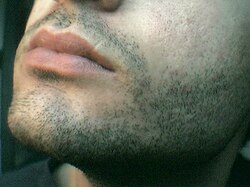چانه
ظاهر
| چانه | |
|---|---|
 دید جلویی گلو (چانه در تصویر دیده میشود ولی برچسبگذاری نشده) | |
| جزئیات | |
| سرخرگها | سرخرگ لثوی پایینی |
| عصبدهی | عصب چانهای |
| شناسهها | |
| لاتین | mentum |
| MeSH | D002680 |
| TA98 | A01.1.00.011 |
| TA2 | 122 |
| FMA | 46495 |
در کالبدشناسی انسان و ادبیات عامیانه، به پایینترین بخش صورت، چانه گفته میشود.[۱][۲][۳][۴]
تورفتگی میان چانه، زَنَخ نام دارد و در ادبیات به چانه زنخدان نیز گفته میشود.
چانه دو قسمت آرواره زیرین را به هم چسبانده و نگه میدارد.[۵][۶][۷] بر روی چانه مردان ریش میروید.[۸][۹][۱۰][۱۱][۱۲]

جستارهای وابسته
[ویرایش]منابع
[ویرایش]- ↑ Stringer CB, Hublin JJ, Vandermeersch B (1984). The origin of anatomically modern humans in western Europe. In F. H. Smith & Spencer (Eds.), The origins of modern humans: a world survey of the fossil evidence. New York. pp. 51–135.
- ↑ Schwartz JH, Tattersall I (March 2000). "The human chin revisited: what is it and who has it?". Journal of Human Evolution. 38 (3): 367–409. doi:10.1006/jhev.1999.0339. PMID 10683306. S2CID 2656256.
- ↑ Robinson L (1913). "The story of the chin". Knowledge. 36: 410–420.
- ↑ Coquerelle, Michael; Prados-Frutos, Juan Carlos; Rojo, Rosa; Drake, Abby Grace; Murillo-Gonzalez, Jorge Alfonso; Mitteroecker, Philipp (September 2017). "The Fetal Origin of the Human Chin". Evolutionary Biology (به انگلیسی). 44 (3): 295–311. doi:10.1007/s11692-017-9408-9. ISSN 0071-3260. S2CID 38431987.
- ↑ Holton NE, Bonner LL, Scott JE, Marshall SD, Franciscus RG, Southard TE (June 2015). "The ontogeny of the chin: an analysis of allometric and biomechanical scaling". Journal of Anatomy. 226 (6): 549–59. doi:10.1111/joa.12307. PMC 4450959. PMID 25865897.
- ↑ Daegling DJ (1993). "Functional morphology of the human chin". Evolutionary Anthropology: Issues, News, and Reviews. 1 (5): 170–177. doi:10.1002/evan.1360010506. S2CID 85195021.
- ↑ Ichim I, Swain M, Kieser JA (July 2006). "Mandibular biomechanics and development of the human chin". Journal of Dental Research (به انگلیسی). 85 (7): 638–42. doi:10.1177/154405910608500711. PMID 16798865. S2CID 28529235.
- ↑ Gröning F, Liu J, Fagan MJ, O'Higgins P (April 2011). "Why do humans have chins? Testing the mechanical significance of modern human symphyseal morphology with finite element analysis". American Journal of Physical Anthropology. 144 (4): 593–606. doi:10.1002/ajpa.21447. PMID 21404235.
- ↑ DuBrul EL, Sicher H (1954). The Adaptive Chin. Springfield, IL: C.C. Thomas.
- ↑ Coquerelle M, Bookstein FL, Braga J, Halazonetis DJ, Weber GW (November 2010). "Fetal and infant growth patterns of the mandibular symphysis in modern humans and chimpanzees (Pan troglodytes)". Journal of Anatomy. 217 (5): 507–20. doi:10.1111/j.1469-7580.2010.01287.x. PMC 3035859. PMID 20807267.
- ↑ چانه در کالبدشناسی انسان (۱۴۰۰-۱۰-۲۰). «ژل چانه». دریافتشده در ۲۰۲۴-۰۹-۰۱.
- ↑ Bastir M. Frayer D (ed.). "Short faces, big tongues: developmental origin of the human chin". PLOS ONE. 8 (11): e81287. Bibcode:2013PLoSO...881287C. doi:10.1371/journal.pone.0081287. PMC 3829973. PMID 24260566.
- مشارکتکنندگان ویکیپدیا. «Chin». در دانشنامهٔ ویکیپدیای انگلیسی، بازبینیشده در ۹ مارس ۲۰۰۸.
در ویکیانبار پروندههایی دربارهٔ چانه موجود است.

